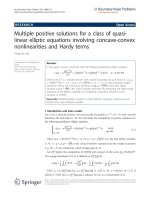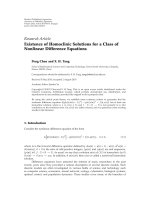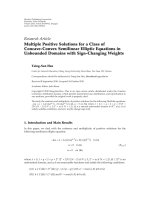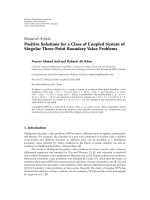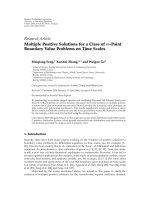DSpace at VNU: Multiple solutions for a class of quasilinear elliptic equations of p(x)-Laplacian type with nonlinear boundary conditions
Bạn đang xem bản rút gọn của tài liệu. Xem và tải ngay bản đầy đủ của tài liệu tại đây (180.11 KB, 14 trang )
Proceedings of the Royal Society of Edinburgh, 140A, 259–272, 2010
Multiple solutions for a class of quasilinear
elliptic equations of p(x)-Laplacian type
with nonlinear boundary conditions
Nguyen Thanh Chung
Department of Mathematics and Informatics,
Quang Binh University, 312 Ly Thuong Kiet,
Dong Hoi, Quang Binh, Vietnam
()
´oc-Anh Ngˆ
Quˆ
o
Department of Mathematics, College of Science,
Vietnam National University, Hanoi, Vietnam, and
Department of Mathematics, National University of Singapore,
2 Science Drive 2, 117543 Singapore
(bookworm )
(MS received 30 July 2008; accepted 4 August 2009)
Using variational methods we study the non-existence and multiplicity of
non-negative solutions for a class of quasilinear elliptic equations of p(x)-Laplacian
type with nonlinear boundary conditions of the form
− div(|∇u|p(x)−2 ∇u) + |u|p(x)−2 u = 0
in Ω,
∂u
= λg(x, u) on ∂Ω,
∂n
where Ω is a bounded domain with smooth boundary, n is the outer unit normal to
∂Ω and λ is a parameter. Furthermore, we want to emphasize that
g : ∂Ω × [0, ∞) → R is a continuous function that may or may not satisfy the
Ambrosetti–Rabinowitz-type condition.
|∇u|p(x)−2
1. Introduction
The study of partial differential equations with p(x) growth conditions has received
an increasing amount of research interest in recent decades. The specific attention
accorded to such problems is due to their applications in mathematical physics.
More precisely, such equations are used to model phenomena that arise in elastomechanics or electrorheological fluids. For a general account of the underlying
physics, and for some technical applications, we refer the reader to [11, 15, 17] and
the references therein.
A typical model of an elliptic equation with p(x) growth conditions is
− div(|∇u|p(x)−2 ∇u) = g(x, u).
The operator div(|∇u|p(x)−2 ∇u) is called the p(x)-Laplace operator and it is a natural generalization of the p-Laplace operator in which p(x) = p > 1 is a constant.
c 2010 The Royal Society of Edinburgh
259
260
N. T. Chung and Q.-A. Ngˆ
o
For this reason the equations studied in the case in which the p(x)-Laplace operator is involved are, in general, extensions of p-Laplacian problems. However, we
point out that such generalizations are not trivial, since the p(x)-Laplace operator
possesses more complicated nonlinearity: for example, it is inhomogeneous.
Let Ω be an open domain in RN and let N
3 with a bounded Lipschitz
boundary ∂Ω. In [5], Fan studied the problem
− div(|∇u|p(x)−2 ∇u) + |u|p(x)−2 u = 0
∂u
= g(x, u)
|∇u|p(x)−2
∂n
in Ω,
(1.1)
on ∂Ω,
(1.2)
where p(·) is a measurable real function defined on Ω, g ∈ C 0 (∂Ω ×R), and satisfies
the following conditions:
(P1) 1 < p− := inf x∈Ω p(x)
p+ := supx∈Ω p(x) < +∞;
(P2) there exist δ > 0 and γ > N such that p ∈ W 1,γ (Ωδ ), where
Ωδ := {x ∈ Ω : dist(x, ∂Ω) < δ};
(G1) there exist a positive constant C1 and a function q ∈ C 0 (Ω) satisfying 1
q(x) < p∗ (x) for x ∈ ∂Ω such that
|g(x, t)|
C1 (1 + |t|q(x)−1 )
for x ∈ ∂Ω, t ∈ R.
The main results of that paper can be formulated as follows.
Theorem 1.1 (Fan [5, theorem 3.5]). Let Ω be an unbounded domain in RN with
bounded Lipschitz boundary ∂Ω. Suppose that conditions (P1), (P2) and (G1) are
satisfied.
(i) If q + < p− , then problem (1.1), (1.2) has a solution that is a global minimizer
of a integral functional on W 1,p(x) (Ω). If, in addition, there exists a positive
constant α < p− such that
lim inf
t→0
G(x, t)
>0
|t|α
uniformly for x ∈ ∂Ω,
then problem (1.1), (1.2) has a non-trivial solution u that is a global minimizer
of an integral functional I with I(u) < 0.
(ii) If the following conditions are satisfied:
(G2) there exist β > p+ and M > 0 such that
0 < βG(x, t)
tg(x, t)
for all x ∈ ∂Ω and all t such that |t| M ; and
G(x, t)
(G3)
lim
= 0 uniformly in x ∈ ∂Ω,
+
t→0 |t|p
where
t
f (x, s) ds,
G(x, t) =
0
then problem (1.1), (1.2) has a non-trivial solution u which is a mountainpass-type critical point of I with I(u) > 0.
Quasilinear elliptic equations of p(x)-Laplacian type
261
Motivated by the ideas introduced in [14] and [16], in the first instance we study
the non-existence and multiplicity of solutions for the following problem:
− div(|∇u|p(x)−2 ∇u) + |u|p(x)−2 u = 0
∂u
|∇u|p(x)−2
= λg(x, u)
∂n
in Ω,
(1.3)
on ∂Ω,
(1.4)
when Ω is a bounded domain and n is the outer unit normal to ∂Ω, when λ > 0
is given, when the function g : ∂Ω × [0, +∞) → R is continuous and the following
hypotheses are satisfied:
(G1 ) g(x, 0) = 0, −C2 tr(x)−1 g(x, t) C3 tp(x)−1 for all t ∈ [0, +∞) and almost
every x ∈ Ω, with some constants C2 , C3 > 0, 1
r(x)
p(x) for almost
every x ∈ Ω;
(G2 ) there exist two positive constants t0 and t1 > 0 such that G(x, t)
0 t t0 and G(x, t1 ) > 0;
0 for
(G3 )
lim sup
t→+∞
G(x, t)
tp+
0
uniformly in x.
It is worth recalling that in [16] Perera deals with quasilinear elliptic equations of pLaplacian type, while in [14] Mih˘
ailescu and R˘
adulescu deal with the corresponding
Dirichlet problem of p(x)-Laplacian. It turns out that essentially similar techniques
on boundary trace embedding theorems for variable exponent Sobolev spaces [5]
can help us to obtain some results on the non-existence and multiplicity of solutions
for (1.3), (1.4). The first results of this paper are given by the following theorems.
Theorem 1.2. Under hypotheses (P1), (P2) and (G1 ), there exists a positive constant λ such that, for all λ ∈ (0, λ), problem (1.3)–(1.4) has no positive solution.
Theorem 1.3. Under hypotheses (P1), (P2), (G1 ) and (G3 ), there exists a posi¯ such that, for all λ λ,
¯ problem (1.3)–(1.4) has at least two distinct
tive constant λ
non-negative, non-trivial weak solutions provided that
p+ < min N,
(N − 1)p−
.
N − p−
One can easily see that theorem 1.2 is new and that theorem 1.3 is different
from theorem 1.1: in theorem 1.3, Ω is a bounded domain and in theorem 1.1 Ω is
unbounded. We also do not require the Ambrosetti–Rabinowitz-type condition as
in (G2). Moreover, we obtain at least two distinct non-negative, non-trivial weak
solutions instead of one, as is the case in theorem 1.1(ii).
Next, we study problem (1.3), (1.4) in the case when
λg(x, t) = A|t|a−2 t + B|t|b−2 t
with A, B > 0 and
1 < a < p− < p+ < b < min N,
(N − 1)p−
.
N − p−
262
N. T. Chung and Q.-A. Ngˆ
o
More specifically, we consider the degenerate boundary-value problem
− div(|∇u|p(x)−2 ∇u) + |u|p(x)−2 u = 0
∂u
= A|u|a−2 u + B|u|b−2 u
|∇u|p(x)−2
∂n
in Ω,
(1.5)
on ∂Ω.
(1.6)
We then conclude with the following result.
Theorem 1.4. There exists λ > 0 such that, for any A ∈ (0, λ ) and any B ∈
(0, λ ), problem (1.5), (1.6) has at least two distinct non-trivial solutions.
The above problems will be studied in the framework of variable Lebesgue and
Sobolev spaces, which will be briefly described in the following section. For a good
survey of related problems, see [1, 3, 6, 7, 10, 13, 15, 19] and the references therein.
2. Preliminaries
In what follows, we recall some definitions and basic properties of the generalized
Lebesgue–Sobolev spaces Lp(x) (Ω) and W 1,p(x) (Ω), where Ω is an open subset of
RN . In that context, we refer the reader to [6, 8, 9, 12, 15].
Set
∞
L∞
+ (Ω) = h; h ∈ L (Ω), ess inf h(x) > 1 .
x∈Ω
For any h ∈ L∞
+ (Ω), we define
h+ = ess sup h(x)
and h− = ess inf h(x).
x∈Ω
x∈Ω
For any p(x) ∈ L∞
+ (Ω), we define the variable exponent Lebesgue space
Lp(x) (Ω) =
u : a measurable real-valued function
|u(x)|p(x) dx < ∞ .
such that
Ω
We recall the following so-called Luxemburg norm on this space defined by the
formula
p(x)
u(x)
|u|p(x) = inf µ > 0;
dx 1 .
µ
Ω
Variable exponent Lebesgue spaces resemble classical Lebesgue spaces in many
respects: they are Banach spaces, the H¨older inequality holds and they are reflexive
if and only if 1 < p− p+ < ∞. An important role in manipulating the generalized
Lebesgue–Sobolev spaces is played by the modular of the Lp(x) (Ω) space, which is
the mapping ρp(x) : Lp(x) (Ω) → R defined by
|u|p(x) dx.
ρp(x) (u) =
Ω
If u ∈ L
p(x)
(Ω) and p < ∞, then the following relations hold:
+
−
|u|pp(x)
ρp(x) (u)
+
|u|pp(x)
Quasilinear elliptic equations of p(x)-Laplacian type
263
provided that |u|p(x) > 1, while
+
|u|pp(x)
−
|u|pp(x) ,
ρp(x) (u)
provided that |u|p(x) < 1 and
|un − u|p(x) → 0 ⇐⇒ ρp(x) (un − u) → 0.
We also define the variable Sobolev space
X := W 1,p(x) (Ω) = {u ∈ Lp(x) (Ω) : |∇u| ∈ Lp(x) (Ω)}.
On X we may consider the following equivalent norms:
u
p(x)
= |u|p(x) + |∇u|p(x) .
A simple calculation shows that the above norm is equivalent to
u = inf µ > 0;
Ω
∇u(x)
µ
p(x)
+
u(x)
µ
p(x)
dx
1 .
Proposition 2.1 (Fan and Zhang [7, proposition 2.5]). There is a constant C > 0
such that
|u|p(x) C|∇u|p(x) for all u ∈ W 1,p(x) (Ω).
By the result of the above proposition, we know that |∇u|p(x) and u are equivalent norms on X. For all u ∈ X, the following well-known inequalities are important
for our argument:
u
p−
(|∇u|p(x) + |u|p(x) ) dx
u
(|∇u|p(x) + |u|p(x) ) dx
u
p+
Ω
provided that u > 1, while
u
p+
p−
Ω
provided that u < 1. We write
⎧
⎨ N p(x)
p (x) = N − p(x)
⎩
+∞
if p(x) < N,
if p(x)
N.
Finally, we recall some embedding results regarding variable exponent Lebesgue–
Sobolev spaces. For the continuous embedding between variable exponent Lebesgue–Sobolev spaces, we refer the reader to [9].
Proposition 2.2 (Fan et al . [9, theorem 1.1]). If p : Ω → R is Lipschitz continuous and p+ < N then, for any q ∈ L∞
q(x) p∗ (x), there is a
+ (Ω) with p(x)
q(x)
continuous embedding X → L
(Ω).
For issues regarding the compact trace embedding we refer to [5].
264
N. T. Chung and Q.-A. Ngˆ
o
Proposition 2.3. (Fan [5, corollary 2.1, theorem 2.2]). Suppose that conditions
(P1) and (P2) are satisfied. Then there is a continuous boundary trace embedding
X → Lq(x) (∂Ω) for q ∈ L∞ (∂Ω) satisfying the condition
1
(N − 1)p(x)
N − p(x)
q(x)
for all x ∈ ∂Ω.
Moreover, the embedding X → Lq(x) (∂Ω) is compact if q ∈ L∞ (∂Ω) satisfies the
condition
(N − 1)p(x)
1 q(x) + ε
for all x ∈ ∂Ω,
N − p(x)
where ε is a positive constant.
3. Proofs
Proof of theorem 1.2. We observe that in [5, p. 1408], Fan has studied the following
eigenvalue problem:
− div(|∇u|p(x)−2 ∇u) + |u|p(x)−2 u = 0
∂u
= λ|u|p(x)−2 u
|∇u|p(x)−2
∂n
in Ω,
(3.1)
on ∂Ω.
(3.2)
Fan then obtains that problem (3.1), (3.2) has a first positive eigenvalue λ1 , given
by
(|∇u|p(x) + |u|p(x) ) dx
Ω
λ1 =
,
(3.3)
min
1,p(x)
|u|p(x) dσ
u∈X\W0
(Ω)
∂Ω
where dσ is the boundary measure. So, if u is a positive solution of problem (1.3)–
(1.4), then multiplying (1.3)–(1.4) by u, integrating by parts and using (G1 ) gives
(|∇u|p(x) + |u|p(x) ) dx = λ
Ω
g(x, u)u dσ
|u|p(x) dσ,
C3 λ
∂Ω
∂Ω
and hence we can choose λ = λ1 /C3 . The proof is complete.
We consider the functional Φλ : X → R given by
Φλ (u) = I(u) − λJ(u),
(3.4)
where
I(u) =
Ω
J(u) =
1
1
|∇u|p(x) +
|u|p(x) dx,
p(x)
p(x)
G(x, u) dσ.
(3.5)
(3.6)
∂Ω
By (P1), the Banach space X is reflexive and the functional I ∈ C 1 (X, R). By
(P2), (G1) and proposition 2.3, we know that there is a compact trace embedding
X → Lq(x) (∂Ω). Furthermore, the functional J is of C 1 (X, R) with
J (u), v =
g(x, u)u dσ
Ω
for all u, v ∈ X.
Quasilinear elliptic equations of p(x)-Laplacian type
265
Definition 3.1. We say that u ∈ X is a weak solution of problem (1.3)–(1.4) if
and only if
|∇u|p(x)−2 ∇u∇v dx +
Ω
|u|p(x)−2 uv dx − λ
Ω
g(x, u)v dσ = 0
∂Ω
for all v ∈ X.
Next we set g(x, t) = 0 for t < 0 and consider the C 1 -functional Φλ : X → R
given by (3.4).
Lemma 3.2. If u is a critical point of Φλ then u is non-negative in Ω.
Proof. Observe that if u is a critical point of Φλ , denoting by u− the negative part
of u, i.e. u− (x) = min{u(x), 0}, we have
0 = Φλ (u), u−
(|∇u|p(x)−2 ∇u · ∇u− + |u|p(x)−2 u · u− ) dx − λ
=
Ω
= u−
g(x, u)u− dx
∂Ω
X.
(3.7)
It is easy to see that if u ∈ X, then u+ , u− ∈ X so, from (3.7), we have u 0 in Ω.
Thus, non-trivial critical points of the functional Φλ are non-negative, non-trivial
solutions of problem (1.3)–(1.4).
The above lemma shows that we can prove theorem 1.3 by using critical point
theory. More precisely, we first show that, for sufficiently large λ > 0, the functional
0 such that Φλ (u1 ) < 0. Next, by using the
Φλ has a global minimizer u1
mountain-pass theorem, a second critical point u2 with Φλ (u2 ) > 0 is obtained.
Lemma 3.3. The functional Φλ is bounded from below, coercive and weakly lower
semi-continuous on X.
Proof. By (G1 ) and (G3 ), there exists a constant Cλ = C(λ) > 0 such that
λG(x, t)
λ1 p(x)
|t|
+ Cλ
2p+
for almost every x ∈ ∂Ω, t ∈ R.
Hence,
Φλ (u) =
Ω
1
p+
1
1
|∇u|p(x) +
|u|p(x) dx − λ
p(x)
p(x)
(|∇u|p(x) + |u|p(x) ) dx −
Ω
1
u
2p+
∂Ω
X
G(x, u) dσ
∂Ω
λ1
|u|p(x) + Cλ dσ
2p+
− Cλ |∂Ω|N −1 .
Since ∂Ω is bounded, the functional Φλ is bounded from below and coercive on
X. On the other hand, by (P1), (P2) and (G1 )–(G3 ), Φλ is weakly lower semicontinuous on X.
266
N. T. Chung and Q.-A. Ngˆ
o
Lemma 3.3 implies, by applying the minimum principle in [18], that Φλ has a
global minimizer u1 and, by lemma 3.2, u1 is a non-negative solution of problem
(1.3)–(1.4). The following lemma shows that the solution u1 is not trivial provided
that λ is sufficiently large.
¯ > 0 such that, for all λ
Lemma 3.4. There exists a constant λ
inf u∈X Φλ (u) < 0. Hence, u1 ≡ 0, i.e. solution u1 is not trivial.
¯ we have
λ,
Proof. Let u0 be a constant function in X such that u0 = t0 , where t0 is as in (G2 ).
We have
1
|t0 |p(x) dx − λ
Φλ (u0 ) =
G(x, t0 ) dσ < 0
p(x)
Ω
∂Ω
¯ This completes the proof.
for all sufficiently large λ λ.
The main difference in the arguments occurs at this point. As mentioned before,
we can prove by a truncation argument that these two solutions are ordered. To
¯ and set
this end, we first fix λ λ
⎧
⎪
for t < 0,
⎨0
gˆ(x, t) = g(x, t)
(3.8)
for 0 t u1 (x),
⎪
⎩
g(x, u1 (x)) for t > u1 (x),
and
t
ˆ t) =
G(x,
gˆ(x, s) ds.
0
ˆλ : X → R by
Define the functional Φ
1
1
|∇u|p(x) +
|u|p(x) dx − λ
p(x)
p(x)
ˆλ (u) =
Φ
Ω
ˆ u) dσ.
G(x,
(3.9)
∂Ω
ˆλ is
With the same arguments as those used for functional Φλ , we can show that Φ
continuously differentiable on X and that
|∇u|p(x)−2 ∇u∇ϕ dx +
ˆλ (u), ϕ =
Φ
Ω
|u|p(x)−2 uϕ dx − λ
Ω
gˆ(x, u)ϕ dσ
∂Ω
for all u, ϕ ∈ X.
ˆλ then u
Lemma 3.5. If u ∈ X is a critical point of Φ
problem (1.3)–(1.4) in the order interval [0, u1 ].
ˆ , then u
Proof. If u is a critical point of Φ
λ
u1 . So u is a solution of
0 as before. Moreover,
ˆ (u) − Φ
ˆ (u1 ), (u − u1 )+
0= Φ
λ
λ
(|∇u|p(x)−2 ∇u − |∇u1 |p(x)−2 ∇u1 )∇(u − u1 ) dx
=
Ω
(|u|p(x)−2 u − |u1 |p(x)−2 u1 )(u − u1 )+ dx
+
Ω
−λ
(ˆ
g (x, u) − g(x, u1 ))(u − u1 )+ dσ
∂Ω
Quasilinear elliptic equations of p(x)-Laplacian type
267
(|∇u|p(x)−2 ∇u − |∇u1 |p(x)−2 ∇u1 )∇(u − u1 ) dx
=
u>u1
(|u|p(x)−2 u − |u1 |p(x)−2 u1 )(u − u1 )+ dx
+
u>u1
(|∇u|p(x)−1 − |∇u1 |p(x)−1 )(|∇u| − |∇u1 |) dx
u>u1
(|u|p(x)−1 − |u1 |p(x)−1 )(|u| − |u1 |) dx,
+
u>u1
which implies u
u1 .
Lemma 3.6. There exist a constant ρ ∈ (0, u1 ) and a constant α > 0 such that
ˆλ (u) α for all u ∈ X with u = ρ.
Φ
Proof. Let u ∈ X be fixed, such that u < 1 and set
Γu = {x ∈ ∂Ω : u(x) > min{u1 (x), t0 }}.
0 on ∂Ω \ Γu . Then
ˆ u(x))
By (G2 ) and (3.8) we have G(x,
ˆλ (u)
Φ
1
u
p+
p
−λ
ˆ u) dσ.
G(x,
Γu
¯
Since p+ < min{N, (N − 1)p− /(N − p− )}, it follows that p+ < p (x) for all x ∈ Ω.
Then there exists q ∈ (p+ , (N − 1)p− /(N − p− )) such that X is continuously
embedded in Lq (Ω). Thus, there exists a positive constant C > 0 such that |u|q
older’s inequality and proposition 2.3,
C u for all u ∈ X. By (G1 ), H¨
ˆ u) dσ
G(x,
|u|p(x) dσ
C3
Γu
Γu
1−p+ /q
C3 |Γu |N −1
u
p+
.
Hence,
ˆλ (u)
Φ
u
p+
1
1−p+ /q
.
− λC3 |Γu |N −1
+
p
It is sufficient to show that |Γu | → 0 as u → 0. Indeed, let k = min{min∂Ω u1 , t0 },
where t0 as in (G2 ). Then
u
p+
|u|p(x) dσ
C
∂Ω
|u|p(x) dσ
+
Ck p |Γu |N −1 .
Γu
This ends the proof of the lemma.
ˆλ is also coercive,
Proof of theorem 1.3. The argument used for Φλ shows that Φ
ˆ
so every Palais–Smale sequence of Φλ is bounded and hence contains a convergent
subsequence. Then all assumptions of the mountain-pass theorem in [2] are satisfied.
We set
ˆλ (u) > 0,
c = inf sup Φ
γ∈Γ u∈γ([0,1])
268
N. T. Chung and Q.-A. Ngˆ
o
where Γ = {γ ∈ C([0, 1], X) : γ(0) = 0, γ(1) = u1 } is a class of paths joining the
origin to u1 . We obtain the second solution u2 and u2 ≡ u1 , since
ˆλ (u2 ) = Φλ (u2 ).
Φλ (u1 ) < 0 < Φ
To prove theorem 1.4, we consider the energy functional Ψλ : X → R corresponding to problem (1.5), (1.6) as follows:
Ψλ (u) =
Ω
1
A
1
|u|p(x) dx −
|∇u|p(x) +
p(x)
p(x)
a
|u|a dσ −
∂Ω
B
b
|u|b dσ.
∂Ω
Similar arguments as those used above assure us that Ψλ ∈ C 1 (X, R) with
(|∇u|p(x)−2 ∇u∇ϕ dx + |u|p(x)−2 uϕ) dx
Ψλ (u), ϕ =
Ω
−A
|u|a−2 uϕ dσ − B
∂Ω
|u|b−2 uϕ dσ
∂Ω
for all u, ϕ ∈ X. Thus, the weak solutions of problem (1.5)–(1.6) are exactly the
critical points of Ψλ . Therefore, our idea is to prove that the functional Ψλ possesses
two distinct critical points using the mountain-pass theorem in [2] and Ekeland’s
variational principle in [4].
Lemma 3.7. The following assertions hold:
(i) there exist three positive constants ρ, λ and α such that Ψλ (u)
u ∈ X with u X = ρ and all A, B ∈ (0, λ );
α for all
(ii) there exists ψ ∈ X such that limt→+∞ Ψλ (tψ) = −∞;
(iii) there exists ϕ ∈ X such that ϕ
small t > 0.
0, ϕ ≡ 0 and Ψλ (tϕ) < 0 for all sufficiently
Proof. (i) Since
1 < a < p− < p+ < b < min N,
(N − 1)p−
,
N − p−
using proposition 2.3 we find that X is continuously embedded in La (∂Ω) and in
Lb (∂Ω). Thus, there exist two positive constants c1 and c2 such that
|u|a dx
∂Ω
c1 u
a
|u|b dx
and
c1 u
b
∂Ω
for all u ∈ X. Therefore, for any u ∈ X with u = 1 we have
Ψλ (u) =
Ω
1
A
1
|∇u|p(x) +
|u|p(x) dx −
p(x)
p(x)
a
A
B
1
− c1 − c2 .
+
p
a
b
|u|a dσ −
∂Ω
B
b
|u|b dσ
∂Ω
Quasilinear elliptic equations of p(x)-Laplacian type
269
Then, taking
λ∗ = min
a
b
,
4p+ c1 4p+ c2
we obtain, for all A, B ∈ (0, λ∗ ), that
Ψλ (u)
1
=α
2p+
for all u ∈ X with u = 1.
(ii) Let ψ ∈ X be a constant function and let ψ
0, ψ ≡ 0 and t > 1. We have
1
1
|∇(tψ)|p(x) +
|tψ|p(x) dx
p(x)
p(x)
Ψλ (tψ) =
Ω
−
A
a
|tψ|a dσ −
∂Ω
B
b
|tψ|b dσ
∂Ω
+
tp
p−
(|∇ψ|p(x) + |ψ|p(x) ) dx −
Ω
B b
t
b
|ψ|b dx.
∂Ω
Since b > p+ we deduce that limt→+∞ Ψλ (tψ) = −∞.
(iii) Let ϕ ∈ X be a constant function, let ϕ
Ψλ (tϕ) =
0, ϕ ≡ 0 and t ∈ (0, 1). We have
1
1
|∇tϕ|p(x) +
|tϕ|p(x) dx
p(x)
p(x)
Ω
A
B
−
|tϕ|a dσ −
|tϕ|b dσ
a ∂Ω
b ∂Ω
−
tp
p−
−
for all t < δ 1/(p
−a)
(|∇ϕ|p(x) + |ϕ|p(x) ) dx −
Ω
A a
t
a
|ϕ|a dx < 0
∂Ω
with
0 < δ < min 1,
(A/a)p+ Ω |ϕ|a dx
.
|∇ϕ|p(x) dx
Ω
It follows that (iii) is proved.
Lemma 3.8. Ψλ satisfies the Palais–Smale condition on X.
Proof. Let λ∗ be defined as above, and let A ∈ (0, λ∗ ) and B ∈ (0, λ∗ ) be fixed.
Assume that {un } is a Palais–Smale sequence in X, i.e.
|Ψλ (un )|
c¯ and Ψλ (un ) → 0
in X .
(3.10)
We first prove that {un } is bounded in X. Indeed, assume by contradiction that
{un } is not bounded in X. Then, passing eventually to a subsequence, still denoted
by {un }, we assume that un → ∞ as n → ∞. Thus, we may consider that
270
N. T. Chung and Q.-A. Ngˆ
o
un > 1 for any integer n. We have, for sufficiently large n,
c¯ + 1 + un
Ψλ (un ) −
=
Ω
−
1
Ψ (un ), un
b λ
1
A
1
|∇un |p(x) +
|un |p(x) dx −
p(x)
p(x)
a
1
b
(|∇un |p(x) + |un |p(x) ) dx +
Ω
A
b
|un |a dx −
∂Ω
|un |a dx +
∂Ω
1
1
−
p+
b
1 1
−
(|∇un |p(x) + |un |p(x) ) dx + A
b a
Ω
1
1
−
p+
b
un
p−
+A
1 1
−
c1 un
b a
a
B
b
B
b
|un |b dx
∂Ω
|un |b dx
∂Ω
|un |a dx
∂Ω
.
From the inequality above we know that {un }n is bounded in X since p+ < b. Thus,
there exists u1 ∈ X such that, passing to a subsequence, still denoted by {un }, it
converges weakly to u1 in X. We know from proposition 2.3 that there is a compact
trace embedding X → Lq(x) (∂Ω). It follows that {un }n converges strongly to u1 in
La (∂Ω) and Lb (∂Ω). On the other hand, relation (3.10) yields
Ψλ (un ), un − u1 = 0.
Using the above information, we find that
|∇un |p(x)−2 ∇un ∇(un − u1 ) dx = 0.
lim
n→∞
(3.11)
Ω
Relation (3.11) and the fact that un converges weakly to u1 in X enable us to
apply [19, proposition 2.6] in order to obtain that un converges strongly to u1 in
X. This completes the proof.
Proof of theorem 1.4. Following from the proof of lemma 3.8, and since Ψ is of class
C 1 and relation (3.10) holds true, we conclude that
Ψλ (u1 ) = 0,
Ψλ (u1 ) = c¯.
It follows that u1 is a non-trivial weak solution of problem (1.5)–(1.6).
We prove now that there exists a second weak solution u2 ∈ X such that u2 = u1 .
By lemma 3.7(i) it follows that, on the boundary of the unit ball centred at the
origin in X and denoted by B1 (0), we have
inf Ψλ > 0.
∂B1 (0)
On the other hand, by lemma 3.7(iii), there exists ϕ ∈ X such that Ψλ (tϕ) < 0 for
all sufficiently small t > 0. Moreover, for any u ∈ B1 (0), the inequality
Ψλ (u)
1
u
p+
p+
−
A
c1 u
a
a
−
B
c2 u
b
b
Quasilinear elliptic equations of p(x)-Laplacian type
271
holds and we deduce that
−∞ < c := inf Ψλ < 0.
B1 (0)
Now let
0 < ε < inf Ψλ − inf Ψλ .
∂B1 (0)
B1 (0)
Applying Ekeland’s variational principle for the functional Ψλ : B1 (0) → R, there
exists uε ∈ B1 (0) such that
Ψλ (uε ) < inf Ψλ + ε,
(3.12)
B1 (0)
Ψλ (uε ) < Ψλ (u) + ε u − uε ,
u = uε .
(3.13)
Since
Ψλ (uε ) < inf Ψλ + ε < inf Ψλ + ε < inf Ψλ ,
B1 (0)
B1 (0)
∂B1 (0)
it follows that uε ∈ B1 (0). Now we define M : B1 (0) → R by M (u) = Ψλ (u) +
ε u − uε . It is clear that uε is a minimum point of M and thus
M (uε + tν) − M (uε )
t
0
for a small t > 0 and ν in the unit sphere of X. The above relation yields
Ψλ (uε + tν) − Ψλ (uε )
+ε ν
t
0.
Letting t → 0, it follows that
Ψλ (uε ), ν + ε ν > 0
ε. We deduce that there exists {un } ⊂ B1 (0) such
and we infer that Ψλ (uε )
that Ψλ (un ) → c and Ψλ (un ) → 0. Using the fact that Ψλ satisfies the Palais–Smale
condition on X, we deduce that {un } converges strongly to u2 in X. Thus, u2 is a
weak solution for the problem (1.5)–(1.6) and, since 0 > c = Ψλ (u2 ), it follows that
u2 is non-trivial. Finally, we point out the fact that u1 = u2 since
Ψλ (u1 ) = c¯ > 0 > c = Ψλ (u2 ).
The proof is complete.
Acknowledgements
The authors express their gratitude to the anonymous referee for a number of
valuable comments and suggestions which helped to improve the presentation of the
paper. This work is supported by National Foundation for Science and Technology
Development (NAFOSTED) Grant no. 101.01.46.09.
272
N. T. Chung and Q.-A. Ngˆ
o
References
1
2
3
4
5
6
7
8
9
10
11
12
13
14
15
16
17
18
19
C. O. Alves and M. A. S. Souto. Existence of solutions for a class of problems in RN
involving the p(x)-Laplacian. In Contributions to nonlinear analysis, Progress in Nonlinear
Differential Equations and Their Applications, vol. 66, pp. 17–32 (Birkh¨
auser, 2005).
A. Ambrosetti and P. H. Rabinowitz. Dual variational methods in critical points theory
and applications. J. Funct. Analysis 4 (1973), 349–381.
P. de N´
apoli and M. C. Mariani. Mountain pass solutions to equations of p-Laplacian type.
Nonlin. Analysis 54 (2003), 1205–1219.
I. Ekeland. On the variational principle. J. Math. Analysis Applic. 47 (1974), 324–353.
X. L. Fan. Boundary trace embedding theorems for variable exponent Sobolev spaces. J.
Math. Analysis Applic. 339 (2008), 1395–1412.
X. L. Fan and X. Han. Existence and multiplicity of solutions for p(x)-Laplacian equations
in RN . Nonlin. Analysis 59 (2004), 173–188.
X. L. Fan and Q. H. Zhang. Existence of solutions for p(x)-Laplacian Dirichlet problem.
Nonlin. Analysis 52 (2003), 1843–1852.
X. L. Fan and D. Zhao. On the spaces Lp(x) (Ω) and W m,p(x) (Ω). J. Math. Analysis Applic.
263 (2001), 424–446.
X. L. Fan, J. Shen and D. Zhao. Sobolev embedding theorems for spaces W k,p(x) (Ω). J.
Math. Analysis Applic. 262 (2001), 749–760.
X. L. Fan, Q. H. Zhang and D. Zhao. Eigenvalues of p(x)-Laplacian Dirichlet problem. J.
Math. Analysis Applic. 302 (2005), 306–317.
T. C. Halsey. Electrorheological fluids. Science 258 (1992), 761–766.
O. Kov´
aˇ
cik and J. R´
akosn´ık. On spaces Lp(x) and W 1,p(x) . Czech. Math. J. 41 (1991),
592–618.
M. Mih˘
ailescu. Existence and multiplicity of weak solutions for a class of denegerate nonlinear elliptic equations. Boundary Value Probl. 17 (2006), 41295.
M. Mih˘
ailescu and V. R˘
adulescu. A multiplicity result for a nonlinear degenerate problem
arising in the theory of electrorheological fluids. Proc. R. Soc. Lond. A 462 (2006), 2625–
2641.
J. Musielak. Orlicz spaces and modular spaces, Lecture Notes in Mathematics, vol. 1034
(Springer, 1983).
K. Perera. Multiple positive solutions for a class of quasilinear elliptic boundary-value problems. Electron. J. Diff. Eqns 7 (2003), 1–5.
M. Ruzicka. Electrorheological fluids: modeling and mathematical theory (Springer, 2002).
M. Struwe. Variational methods, 2nd edn (Springer, 2000).
Q. H. Zhang. Existence of radial solutions for p(x)-Laplacian equation in RN . J. Math.
Analysis Applic. 315 (2006), 506–516.
(Issued 9 April 2010 )

